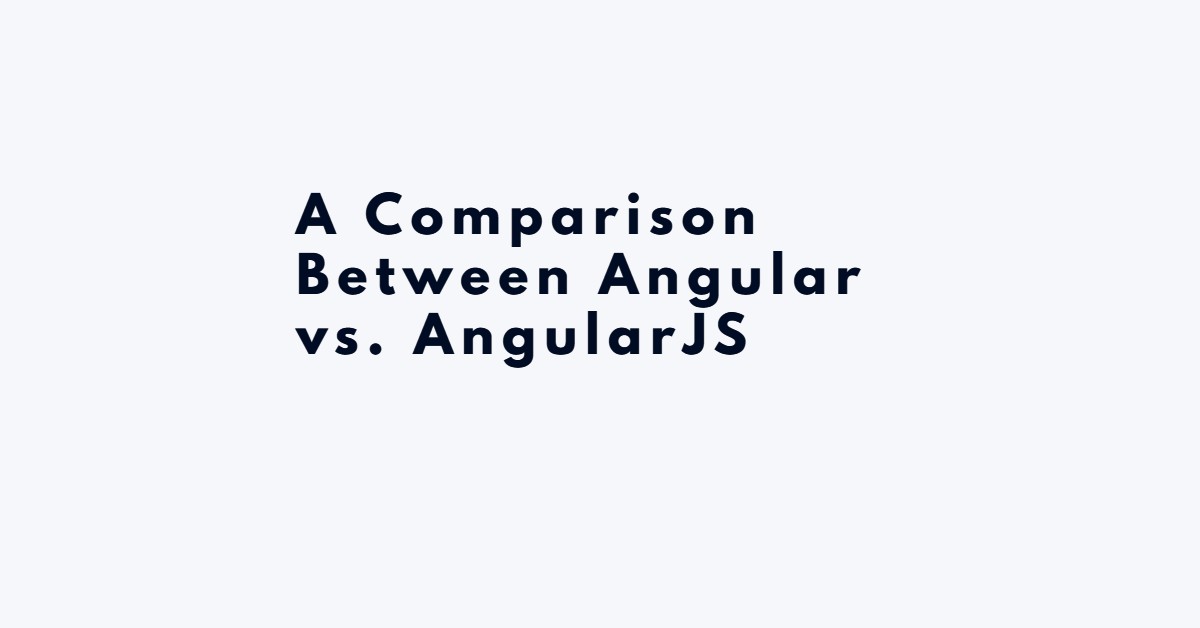A Comparison Between Angular vs. AngularJS

Knowing the difference between Angular vs AngularJS frameworks is important because it allows you as a developer to apply them properly. Read on for distinctions between Angular vs AngularJS.
The main difference between angular vs angularjs is that the Angular framework is based on TypeScript while AngularJS is based on JavaScript. These two frameworks also have a few similarities. They are both front-end and open source frameworks that allow developers and programmers to create dynamic Spas. Today we are exploring the various differences that separates these two frameworks.
Components that Make Up Angular vs AngularJS
The reason why Angular is known to be TypeScript based and AngularJS to be JavaScript-based are their varying components. Each one of them is made of different components.
Angular uses the TypeScript that has a superset of ES6. The superset has backward compatibility with ES5. While Angular utilizes a hierarchy of components, the JavaScript-based AngularJS framework uses terms of controllers and scope. Directives are used in AngularJS, but Angular is component-based.
Angular vs AngularJS: Use of Directives
Both Angular and AngularJS use directives, but each uses them differently. The Directives in Angular are not as many as they are in AngularJS. While a programmer is using these Directives, extra care has to be taken. For example, if you intend to create a one-way binding in AngularJS, then using NG-bind is appropriate. They are using the ng-model. Is ideal for creating a two-binding.
You will only find the ngModel in the Angular framework. Symbols can also be used as follows:
- One-way binding as:” [],”
- Two-way binding as:” [()].”
- Property binding as:“[]”
- Event binding as: “()”
Angular vs AngularJS Architecture
- AngularJS
The Angular framework has a model-view-controller (MVC). Since the MVC manages logic, data, rules, and application behavior, it has a central component. The area where data management is stored is known as a model. View refers to the generation of the output once the output information is viewed in the model. The input is received by the controller, which is converted into commands and sent to the view and model.
- Angular
Components that are directives with templates are used in the Angular framework. In Angular, there are two kinds of directives. They include:
Structural Directives – The main function of structural directives is to alter the layout of DOM, by replacing its elements.
Attributive Directives – Attributive directives, on the other hand, change the behavior of DOM and the element’s appearance.
Mobile Support
While support for mobile devices is there in Angular, there is no support for mobile devices in AngularJS.
Speed and Performance
In AngularJS, the time and effort used in the construction of two-way binding features are greatly reduced.
On the other hand, there is improvement in speed and performance in the Angular framework since it is upgraded to a better structure.
Tool support
The AngularJS framework depends on tools such as WebStorm and IDE, which are third-party tools.
Command Line Interface (CLI) is used in the Angular framework, which shortens the time as applications are created—creating applications.
Benefits of Angular vs AngularJS Frameworks
- Angular
Modularity – The creation of a lighter and faster core is due to the moving of the framework’s core functionality.
Dynamic Loading – For reactive programming, there is added support and a combination of asynchronous templates.
AOT/Ahead-of-Time – During the building process, HTML and TypeScript are converted into JavaScript with the help of this compilation. Faster rendering is achieved when AOT compiles the code, and the browser loads the compiled code.
CLI – Server angular applications are created with the help of Command Line Interface. Testing is more accessible while project building is taken care of.
The Architectural Component – The work of architectural components is to assist in dividing the logical and functional components.
Dependency Injection – In Angular, unidirectional change detection is used. Instead of using directives like AngularJS, Angular utilizes Hierarchical Dependency Injection to enhance the performance of the framework significantly.
Language – Besides being written in TypeScript, Angular can also be written in other language options which are used for coding, including ES5, ES6, and Dart.
Routing – There is a simple path used in the Angular framework. For Angular to navigate to the client view, it interprets a URL as a directive.
- AngularJS
MVC – To accelerate application development, data binding is used by the Model View Controller. A conclusive interface is provided using POJO Models and two-way data binding that allows a programmer to use less code in projects.
A continuously updated and ready unit testing feature comes with the AngularJS framework. Any defects in the design can be detected by the developer using code.
Since AngularJS doesn’t rely on plugins and other frameworks, it offers a comprehensive solution for frontend development.
Angular is quite intuitive due to the declarative language it uses.
Reusable components are provided to the user by the AngularJS framework.
Development of web and mobile apps is made quicker since AngularJS has a much simpler architecture.
Conclusion
The Angular and AngularJS frameworks both have great benefits despite their differences. The two frameworks are maintained by Google, meaning that they both have extensive community support. However, Angular seems to outdo AngularJS because it is used to create dynamic mobile and web applications. Single-page applications can also be created by Angular using HTML and TypeScript.
Naman Modi is a Professional Blogger, SEO Expert & Guest blogger at ebuilderz.com, He is an Award-Winning Freelancer & Web Entrepreneur helping new entrepreneur’s launches their first successful online business.






